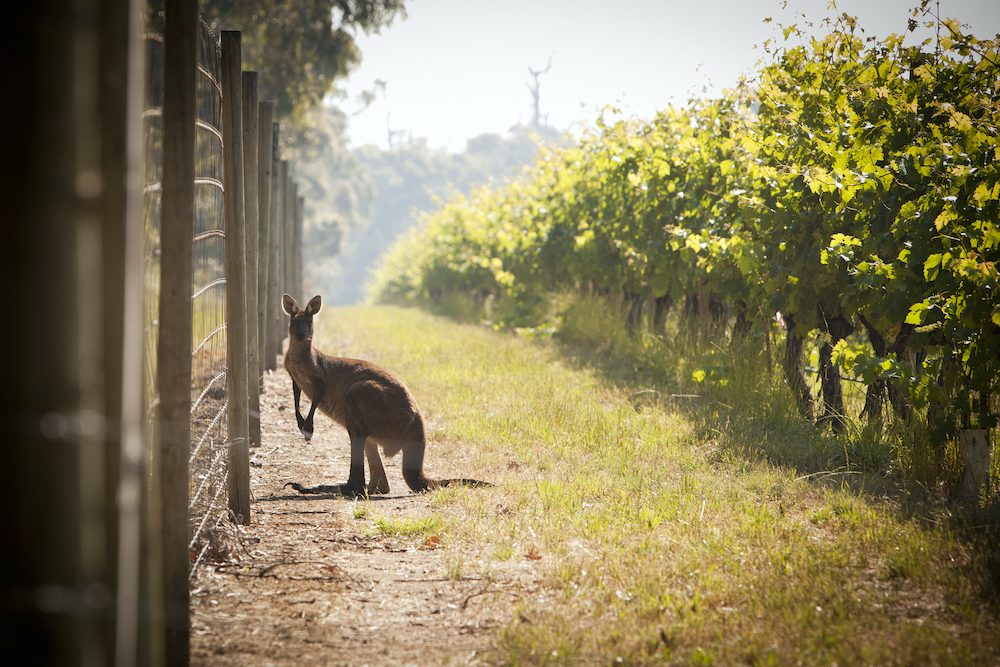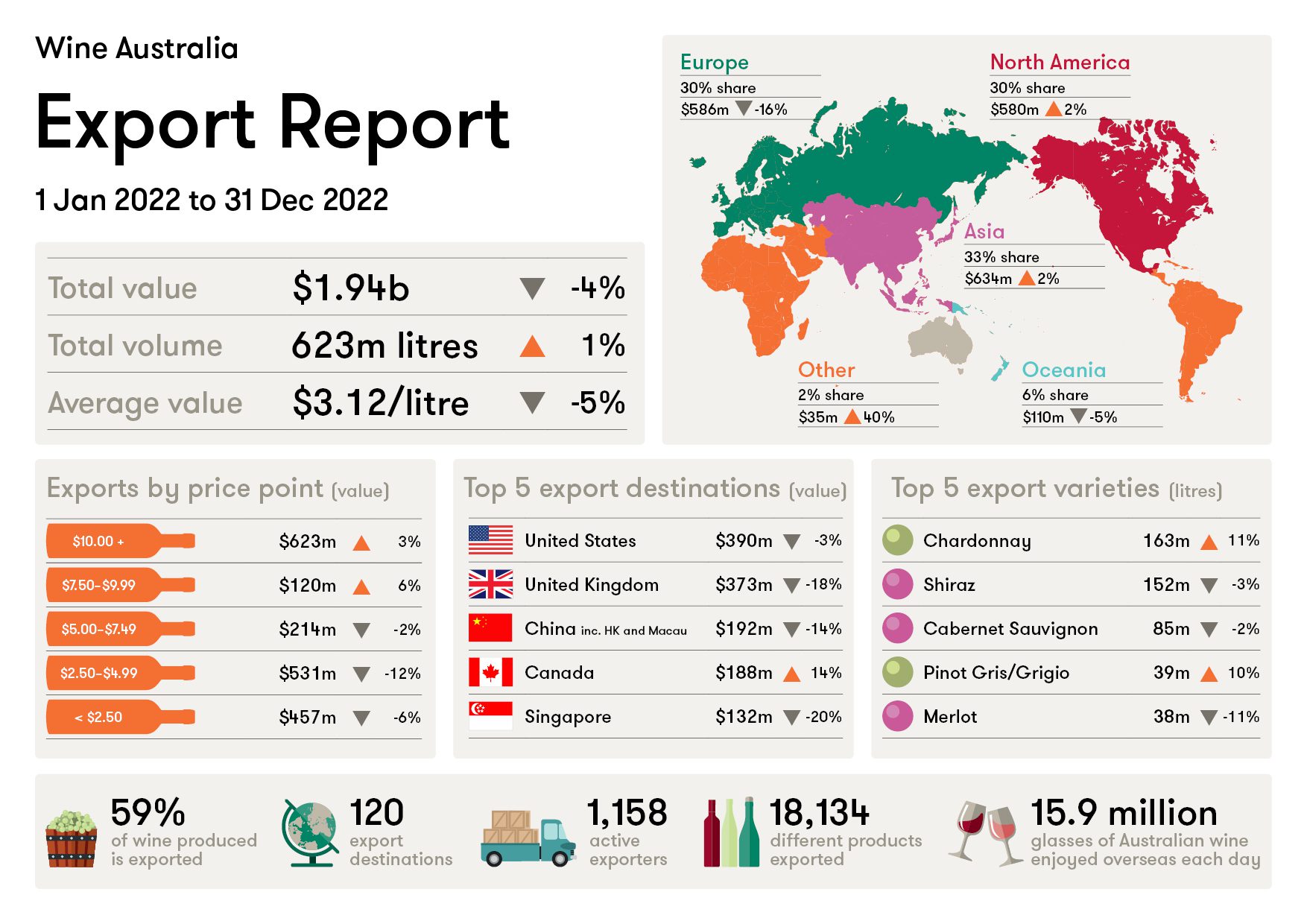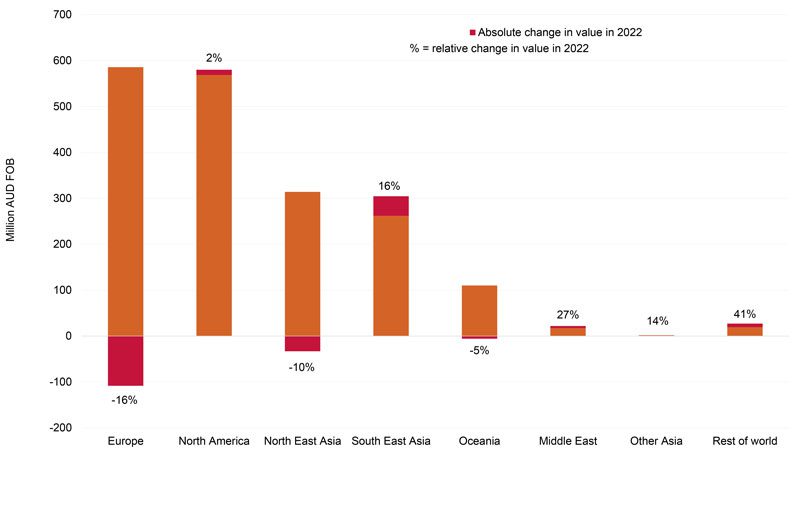
Australian wine exports increased by one percent in volume to 623 million litres – but declined by four percent in value – to $1.94 billion in the year ended 31 December 2022, according to Wine Australia’s latest Export Report.
“The rise in volume relative to value was driven by growth in the shipments of unpackaged wine, particularly to the United States and Canada, as global shipping challenges improve,” manager of Market Insights Peter Bailey says.
Exporters shipped wine to 120 destinations, up from 112 the previous year and the highest since the start of the pandemic.
Growth in the value of exports to Southeast Asia continued with a 16 percent rise in value to $305 million.
It was another tough year for Australian wine exporters, with rising inflation, business costs and interest rates impacting margins.
“And it is anticipated this will continue in 2023,” Mr Bailey says.
He says the increase in unpackaged wine exports is an indication of improvements to the significant shipping challenges in some markets, which have been a factor since 2021.
“It was pleasing to see positive signs of improvements emerging in shipping conditions in some markets, noting delays are still being reported along certain trade routes,” Mr Bailey says.
“Shipments of 2021 and 2022 vintage wines had been largely delayed due to the shipping challenges, particularly unpackaged shipments.
“As these conditions eased in the latter half of 2022 in some regions, Australian wine producers were finally able to ship their products to customers overseas.
“This increase in the share of unpackaged wine shipments contributed to the decline in the total value of exports, as unpackaged wine is shipped at a lower average free-on-board value because packaging costs are excluded.”
Increases in the value of exports to Thailand, Malaysia and Canada offset declines in value to Singapore, Hong Kong and the US.
However, decreased shipments to the UK in the second half of 2022 were greater than the increase in overall value to other markets.
“This drop was anticipated,” Mr Bailey says, “as Australia experienced two years of elevated shipments as a result of Brexit deadlines and increased demand for wine in the off-trade (supermarkets and bottle shops) during the Covid-19 pandemic when many on-trade businesses were closed.”
The decline in the overall value of exports was driven by shipments valued below $5 per litre free-on-board (FOB), which declined by nine percent to $988 million. Exports in this segment declined in value in a number of markets – including the UK, US, Denmark, Germany, the Netherlands and New Zealand.
Meanwhile, exports above $5 per litre increased by two percent in value to $957 million.
The markets driving this trend were Thailand, Malaysia, Canada, Denmark and Japan. Growth to these markets has been partially offset by a decline in exports in this price segment to Singapore, Hong Kong and the UK.
“Contributing most to the growth above $5 per litre were exports valued above $10 per litre, which grew by three percent in value to $623 million,” Mr Bailey says.
“This price segment increased its share of packaged exports in many destinations, which aligns with premiumisation trends in mature markets of wine consumers drinking less, but higher priced, wine.”
The top five markets by value were:
- US (down three percent to $390 million – 20 percent value share of total export value);
- UK (down 18 percent to $373 million – 19 percent share of total export value);
- Canada (up 14 percent to $188 million – 10 percent share of total export value);
- Hong Kong (down 13 percent to $167 million – nine percent share of total export value); and
- Singapore (down 20 percent to $132 million – seven percent share of total export value).
The top five markets by volume were:
- UK (down 11 percent to 216 million litres – 35 percent share of total export volume);
- US (up 13 percent to 140 million litres – 23 percent share of total export volume);
- Canada (up 46 percent to 68 million litres – 11 percent share of total export volume);
- Germany (down 15 percent to 29 million litres – five percent share of total export volume); and
- New Zealand (down six percent to 29 million litres – five percent share of total export volume).

Figure 1: Export value growth/decline by region
North America
In 2022, Australian wine exports to North America increased by two percent to $580 million.
Exports to the US declined by three percent in value to $390 million and increased in volume by 13 percent to 140 million litres. As volume growth outpaced value, the average value dropped by 14 percent to $2.78 per litre. The number of exporters to the US grew by five percent to 303, the highest since 2008.
Exports to Canada increased by 14 percent in value to $188 million and 46 percent in volume to 68 million litres. The average value of exports declined by 22 percent to $2.76 per litre FOB.
Driving the growth for both markets was the rise in unpackaged wine shipments, increasing in volume by 67 percent to 76 million litres in the US and up by 81 percent to 44 million litres in Canada. Packaged exports on the premium end of the price spectrum also grew in both markets. Exports to Canada valued at $5 per litre and above grew by 13 percent to $114 million, while exports to the US above $10 per litre grew by four percent to $50 million.
 Europe
Europe
Australian wine exports to Europe declined by 16 percent to $586 million.
Since Brexit was announced in 2016, exports to the UK have been unpredictable and there have been several peaks and troughs during this time. In the latest figures, Australian wine exports to the UK declined in value by 18 percent to $373 million and in volume by 11 percent to 216 million litres. The average value of exports also declined, by eight percent to $1.72 per litre FOB.
Australian wine holds the number one position in the UK off-trade – a category that benefitted from the closure of the on-trade during the Covid-19 pandemic, and as the on-trade reopened in 2021 and 2022, there was a counter-swing in the demand for Australian wine as Australia’s share in the on-trade is substantially lower. However, as the off-trade sales volume of wine has declined, Australia has seen a smaller reduction than the total market, declining by four percent in volume in the year ended December 2022, while the total off-trade wine market declined by eight percent (IRI Worldwide).
European markets are experiencing tough operating conditions. Nearly every European destination declined during 2022, with the largest contributor to the decrease, besides the UK, being Germany (down 22 percent in value to $38 million), followed by the Netherlands (down 19 percent to $29 million) and Denmark (down 13 percent to $37 million).
Asia
Exports to Southeast Asia increased by 16 percent in value to $305 million. Exports to all key Southeast Asian destinations increased, with the exception of Singapore. The main drivers behind this growth were Thailand (up 118 percent to $62 million) and Malaysia (up 78 percent to $61 million). A decline in the value of exports to Singapore, down 20 percent to $132 million, offset some of these gains. Singapore remains the number one destination in Southeast Asia for Australian wine exports but is a trading hub and some of the wine is on-shipped to other Asian markets. As with all trading hubs globally, export levels can vary to these markets depending on changes in business practices of shipping directly to the selling destination or vice versa.
Exports to Northeast Asia declined by 10 percent in value to $314 million and 15 percent in volume to 32 million litres. The results in this region were mixed – with markets such as Hong Kong and mainland China continuing their decline. Growth in exports to Japan offset some of this loss, up by eight percent to $51 million and driven by exports above $10 per litre, which reached a calendar year record of $13 million. The number of exporters to Japan grew by 23 percent to 260 in 2022, up from 211 in 2021. While exports to South Korea declined overall, the above $10 segment showed strong growth, up 28 percent to $26 million.
Photograph: Cape Mentelle, Margaret River.














Recent Comments